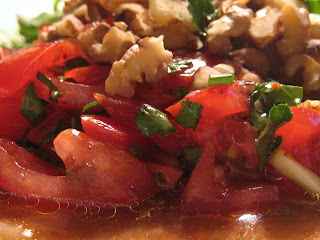 Spring has sprung, and with it spring lamb, spring peas, broad beans, asparagus, and strawberries popping up on Oxford and London menus quicker than you can say Chelsea Flower Show.
Spring has sprung, and with it spring lamb, spring peas, broad beans, asparagus, and strawberries popping up on Oxford and London menus quicker than you can say Chelsea Flower Show.On a recent visit to London amidst the clamour and glamour of the RHS hullabaloo, I was able to escape to the quieter corners of Mayfair for some gastronomic pampering. The highlight of my London jaunt was, without hesitation, The Greenhouse. Tucked away behind an unassuming garden in Hay’s Mews, the Zen lighting, garden view, and minimalist, clean décor truly allows the food and wine to stand on its own.
The staff was at once warm, unobtrusive, incredibly attentive and not at all self-impressed. A rare and delicate balance indeed. If a napkin or piece of cutlery went awry, someone leapt to the table, yet I never once had the impression of being surveyed. All of the dishes were explained with an air of quiet assurance rather than stiff, let’s-see-how-complicated-we-can-make-this-sound kind of flair.
The sommelier was both charming and knowledgeable, offering suggestions that made choices from the tome of the wine list a manageable affair. Many of the reviews I’ve read of The Greenhouse moan—not unreasonably—about the prices on the wine list, but I was very happy with the suggested red that accompanied my Magret de canard with cherries, smoked potato mash and fresh almond cream (the ‘Modern Classic’ special that evening), and C., G., and I unanimously relished the arrival of the champagne trolley that opened the meal.
The amuses bouches to start and between each course were superb. ‘Sliders’ of gelled watercress filled with the essence of spring green vegetables were like having a garden explode on the palate, and herbed creme sandwiched between miniature disks of parmesan croûtes were simple and perfectly executed. My terrine de foie gras de maison with pear and lemon chutney was the best I’ve had outside of France and the warm, just-out-of-the-oven brioche that arrived with it sat on its mini slab of slate as a golden temple to be idolized by every inferior brioche ever conceived. The second round of amuses was a mustard green gelée with cauliflower mousse and toasted nutmeg served in an urchin shell, and the palate cleanser consisted of a mint sorbet with a citrus custard and grapefruit foam—delightful in its balance of fresh mint and citrus acid.
The only course where things began to falter was dessert. Where the mousse-y, foam-y, fussiness
 had been so wonderfully executed and welcomed in the amuses, incorporating such a deconstructed attitude towards a pudding billed as ‘carrot and orange cake’ can only disappoint. I think it is fortunate that such a strong reserve was shown throughout the menu in terms of keeping these mousses and gelées where they belong—off the à la carte and contained as amuses on their precious bits of slate, where their texture as such (as a flavour that floods and/or cleanses the palate) serves a purpose. My ‘cake’, on the other hand, had little to offer by way of any gluten-based compound that I was so looking forward to. The miniature pads of biscuit that supported a far-too-tart, impressive as it may have been, apparatus of dehydrated carrot ribbon and carrot/orange sorbet left me feeling summery but unsatisfied.
had been so wonderfully executed and welcomed in the amuses, incorporating such a deconstructed attitude towards a pudding billed as ‘carrot and orange cake’ can only disappoint. I think it is fortunate that such a strong reserve was shown throughout the menu in terms of keeping these mousses and gelées where they belong—off the à la carte and contained as amuses on their precious bits of slate, where their texture as such (as a flavour that floods and/or cleanses the palate) serves a purpose. My ‘cake’, on the other hand, had little to offer by way of any gluten-based compound that I was so looking forward to. The miniature pads of biscuit that supported a far-too-tart, impressive as it may have been, apparatus of dehydrated carrot ribbon and carrot/orange sorbet left me feeling summery but unsatisfied.In the end, however, it was refreshing to experience food that maintained a level of honesty and modesty while clearly having been prepared with the utmost attention towards presentation and complementary pairings of texture, flavour and seasoning--a sad rarity, it seems, among Michelin starred and star-seeking kitchens.
This experience was in stark contrast to recent accounts of trips to Le Cercle on Wilbraham Place off of Sloane Square and to Summer Lodge in Evershot, West Dorset where a conflation of foams and insufferable staff, respectively, achieved wholly unpleasant experiences. Am I the only one who’s fed up with the likes of what is essentially a sub-par first course salad appearing on a menu as ‘carpaccio of beetroot, deconstructed rémoulade, and asparagus foam’? In fact, a moratorium on foams should be imposed conditional upon a published caveat that states clearly how, exactly, said foam truly constitutes an essential component to the dish in question. Call me a heathen purist, but I can’t help but be suspicious of the quality of produce being served that absolutely necessitates it being rendered as a foam or mousse. Cue cries of ‘textural variety’ now. At the very least, ample specimens of the unadulterated product should be served simultaneously so as to present the choice of whether a blob of green resembling the Gak of my childhood really does capture the essence of a spring pea better than the sweet, bursting pearls themselves.
The Greenhouse is located at
27A Hay's Mews, Mayfair
London WIJ 5NY
+44 (0)20 7499 3331
reservations@greenhouserestaurant.co.uk











